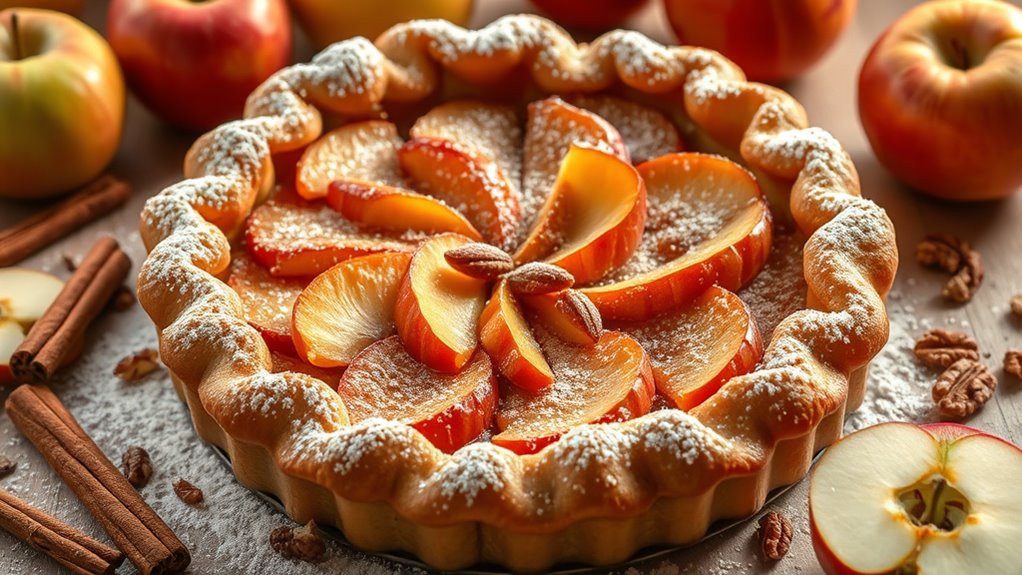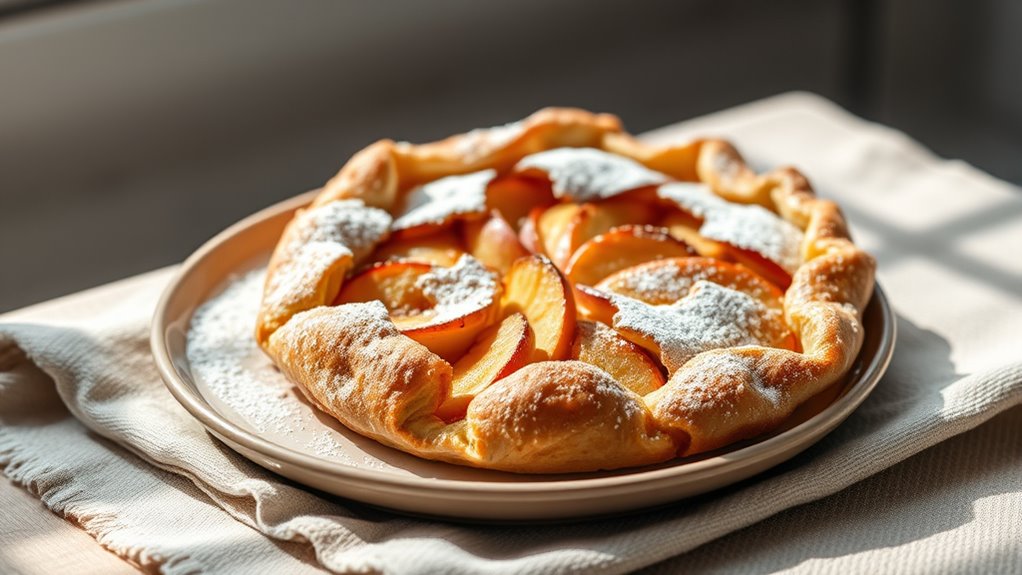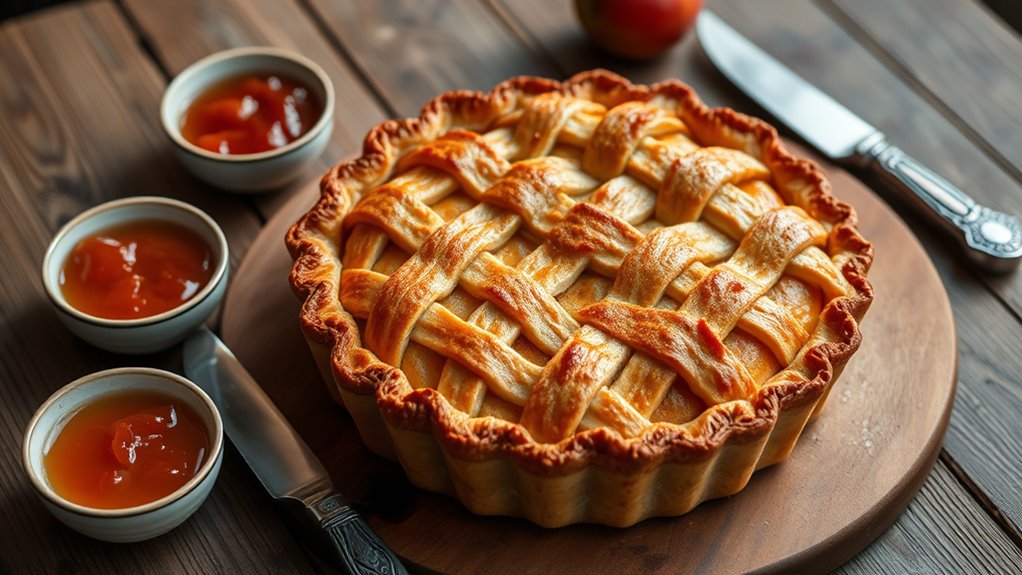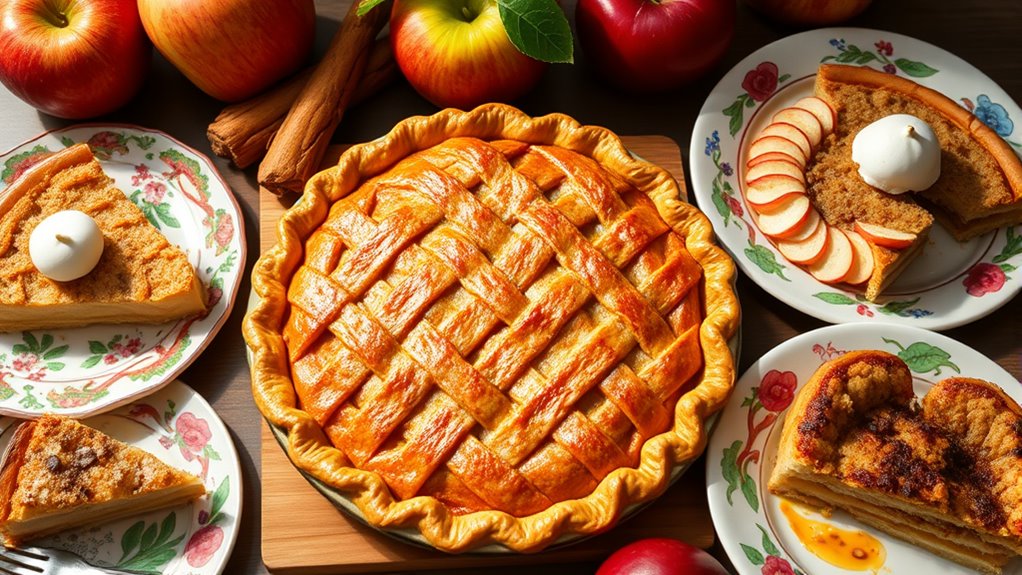Around the world, classic apple pie varies in flavor and presentation. In America, it’s flaky, sweet, and often spiced with cinnamon, served with ice cream. France offers the caramelized upside-down Tarte Tatin, while Britain prefers a warm, spiced pie with custard. Germany showcases rich Apfelkuchen, and Scandinavians keep it simple with thin slices. Australians bring modern twists, incorporating native ingredients. If you want to explore even more fascinating variations, there’s much more to discover.
Key Takeaways
- Traditional apple pie varies globally, including American, French, British, German, and Scandinavian styles, each with unique ingredients and techniques.
- American apple pie features a flaky crust with sweet-tart apples, often flavored with cinnamon and nutmeg.
- French Tarte Tatin is an upside-down caramelized apple tart emphasizing deep caramel flavors.
- British recipes typically use Bramley apples, served warm with custard or cream for comfort.
- Variations incorporate native ingredients like wattleseed and finger lime, reflecting Australia’s culinary culture.
The American Classic: A Slice of Tradition

Have you ever wondered what makes an American apple pie so iconic? It’s the perfect balance of sweet and tart apples nestled in a flaky, golden crust. You probably picture it with a lattice top, inviting you to take a bite. The filling uses varieties like Granny Smith or Honeycrisp, providing a crisp texture and vibrant flavor. You might add a dash of cinnamon and nutmeg to enhance the warmth and aroma. Baking it to golden perfection fills your home with an irresistible scent. Served warm with a scoop of vanilla ice cream or a dollop of whipped cream, it’s a comforting dessert rooted in American tradition. Additionally, using high-quality ingredients can elevate the overall flavor and texture of the pie. Incorporating traditional baking techniques ensures a perfectly flaky crust and well-balanced filling. As the popularity of AI-enhanced culinary techniques grows, innovative twists on traditional recipes like apple pie are emerging, blending technology with classic comfort.
French Tarte Tatin: An Upside-Down Delight

While American apple pie often features a traditional baked crust, France offers a different approach with the Tarte Tatin—an upside-down caramelized apple tart that turns the dessert on its head. You begin by caramelizing sugar and butter in a skillet, then add sliced apples, cooking them until tender and richly coated. Instead of a top crust, you cover the apples with pastry dough and bake the whole thing in the oven. Once baked, you carefully invert the tart onto a plate, revealing glossy, golden apples on top. The result is a decadent, caramel-glazed treat with a tender, flaky crust. Tarte Tatin combines simplicity and elegance, highlighting the natural sweetness of apples with a deep, caramelized flavor that’s uniquely French. Additionally, understanding the emotional connection involved in traditional recipes can deepen appreciation for cultural culinary techniques.
British Apple Pie: A Cozy Favorite

British apple pie is a comforting classic that has warmed hearts for generations. You’ll love how its flaky, buttery crust perfectly encases tender, spiced apples. Typically, you use Bramley apples, which hold their shape and provide a tart contrast to the sweet filling. The pie is often served warm, topped with a scoop of custard, cream, or a dollop of clotted cream for added richness. Many families cherish this dessert as a cozy treat, especially during colder months. It’s a simple yet satisfying dish that captures the essence of home baking. Whether enjoyed as a family dessert or with tea, British apple pie evokes a sense of nostalgia and comfort in every bite.
German Apfelkuchen: A Rich, Fruit-Studded Treat

German Apfelkuchen is renowned for its rich, buttery crust and generously layered apples, creating a delightful balance of sweetness and tartness. As you take a bite, you’ll notice the moist, tender apples embedded in a soft, golden crust. Often, slices of apples are arranged in decorative patterns on top, adding visual appeal. The filling is infused with cinnamon and sugar, enhancing the fruit’s natural flavor. You might also find a hint of lemon zest or vanilla to brighten the taste. Unlike some American apple pies, Apfelkuchen tends to be less crumbly and more cake-like, making it a versatile treat. It’s often served with a dusting of powdered sugar or a dollop of whipped cream, perfect for enjoying with a cup of coffee or tea. Incorporating vintage decor elements into the presentation can add an extra layer of charm to your serving experience. For an authentic experience, many bakers use traditional baking techniques that have been passed down through generations. Understanding the cultural significance of Apfelkuchen can deepen appreciation for this beloved dessert, and practicing mindful organization in your baking supplies can help streamline your kitchen setup. Additionally, exploring AI applications in culinary arts can inspire innovative twists on classic recipes.

Scandinavian apple tarts embody a sense of understated elegance through their simple yet refined design. You’ll notice they often feature a thin, flaky crust that provides a delicate base, topped with thinly sliced apples arranged in neat, concentric circles. The focus is on highlighting the natural sweetness and tartness of the apples, so the filling is lightly seasoned with cinnamon or a touch of sugar. These tarts emphasize minimalism, avoiding heavy sauces or excessive decoration. Instead, they rely on quality ingredients and clean presentation to create a sophisticated look. You might enjoy them warm with a dollop of whipped cream or a scoop of vanilla ice cream. Their effortless beauty makes Scandinavian apple tarts a perfect choice for any occasion that calls for elegance without fuss. Additionally, paying attention to traditional pastry techniques can also enhance the texture and appearance of the crust, elevating the overall presentation. For an extra touch of refinement, using precise dough handling can help achieve the ideal flaky and tender crust texture. Incorporating baking best practices ensures consistent results and enhances the tart’s visual appeal.
Australian Apple Pie Variations: A Modern Twist

Australian apple pies often feature unique flavors like Vegemite or wattleseed, giving them a distinctive local twist. Modern styles incorporate ingredients such as caramel, puff pastry, or even gluten-free crusts to update the classic. You’ll notice how these contemporary variations blend tradition with innovation to create something truly Australian. Additionally, some bakers focus on delicate crust textures to enhance the overall experience, reflecting the attention to detail found in local baking traditions. Incorporating smart marketing strategies such as social media promotion and customer engagement can help showcase these innovative pies to a wider audience. Using sound design techniques, such as capturing ambient sounds of the baking process, can further elevate the sensory appeal of these modern desserts. Furthermore, hosting virtual hackathons focused on culinary innovation could inspire new ways to elevate traditional recipes and reach broader audiences. Incorporating community engagement strategies can also foster stronger local connections and increase interest in these unique variations.
Unique Aussie Flavors
While traditional apple pies remain beloved, innovative Australian variations often incorporate local flavors that give them a modern twist. You might find pies infused with native ingredients that highlight the country’s unique culinary identity. Here are some popular Aussie flavor ideas:
- Wattleseed – adds a nutty, earthy richness to the filling.
- Finger Lime – offers a burst of tangy, citrusy flavor.
- Macadamia Nuts – bring crunch and buttery depth.
- Bush Tomato – introduces a savory, slightly spicy note.
These ingredients elevate the classic apple pie, making each bite distinctly Australian. Whether used as a filling ingredient or topping, they reflect local flavors that surprise and delight your palate. Embracing cultural culinary influences can transform a simple dessert into a celebration of Australian ingredients and innovation.
Contemporary Pie Styles
Contemporary pie styles showcase how traditional apple pies can be reimagined with modern techniques and local ingredients. In Australia, bakers are blending classic flavors with innovative twists, like adding native fruits such as finger lime or wattleseed for a unique flavor profile. You might try a deconstructed apple pie, where the elements are presented separately for a modern look and feel. Others experiment with gluten-free or vegan crusts, catering to diverse dietary needs. Incorporating fresh, seasonal ingredients makes each pie a reflection of current trends and local produce. Exploring specialty teas can inspire unique flavor pairings to complement these modern desserts. Additionally, understanding culinary innovation helps bakers push the boundaries of traditional recipes, making each creation a distinctive experience. Embracing creative practice can inspire bakers to develop new recipes and presentation styles that resonate with contemporary audiences. For example, some bakers utilize advanced baking tools like vacuum-sealing techniques to experiment with textures and flavors. Developing a self-awareness of emerging culinary trends can further enhance the originality of these modern pies.
Frequently Asked Questions
What Are Common Regional Variations of Apple Pie Worldwide?
You’re curious about regional variations of apple pie worldwide. You’ll find that in the US, they prefer flaky crusts with sweet, cinnamon-spiced filling. In France, tarte tatin features caramelized apples baked upside down. In the UK, you might enjoy a rustic, crumb-topped apple crumble. Australia adds rhubarb, while Germany offers apple strudel with thin, flaky pastry. Each region adapts apple pie to local tastes and ingredients, making it uniquely delicious everywhere.
How Do Different Cultures Incorporate Local Ingredients Into Apple Pie?
They say, “Variety is the spice of life,” and this holds true in how cultures adapt apple pie. You’ll see locals incorporating ingredients like cinnamon, nutmeg, or even exotic spices, along with regional fruits or nuts, to give it a unique twist. Some add caramel, cheese, or local liquors, making each pie a reflection of local flavors. This creative fusion celebrates diversity and shows how tradition evolves worldwide.
Are There Traditional Methods for Baking Apple Pie in Various Countries?
You might wonder if traditional baking methods vary across countries for apple pie. In many places, you’ll find that techniques like using a lattice crust, baking in a brick oven, or incorporating local spices are common. Some cultures prefer steaming or frying their pies instead of baking. These methods reflect local traditions, ingredients, and climate, giving each apple pie its unique flavor and texture that ties back to its cultural roots.
What Are the Historical Origins of Apple Pie in Different Regions?
You’re curious about the historical roots of apple pie across regions. You’ll find that its origins trace back to medieval Europe, especially England and the Netherlands, where apple cultivation flourished. When exploring different areas, you notice variations influenced by local ingredients and traditions. For example, American apple pie evolved with new ingredients and techniques, blending European roots with Native American influences, creating a symbol of comfort and national identity.
How Do Presentation Styles of Apple Pie Differ Globally?
You notice that presentation styles of apple pie vary globally. In the US, you see lattice-topped pies or deep-dish versions, often served whole or sliced. In France, you might find individual tartlets with delicate crusts, while in the UK, apple pies are usually served with a generous scoop of custard or cream. These differences reflect local traditions, ingredients, and cultural preferences, making each style uniquely appealing.
Conclusion
No matter where you go, apple pie brings comfort and joy. From the classic American slice to the elegant French Tarte Tatin, each variation tells a unique story. So, why not try baking one from each country and discover your favorite? With so many delicious options, isn’t it worth exploring these sweet traditions? Embrace the global flavors and make your own delicious world tour—one apple pie at a time!









